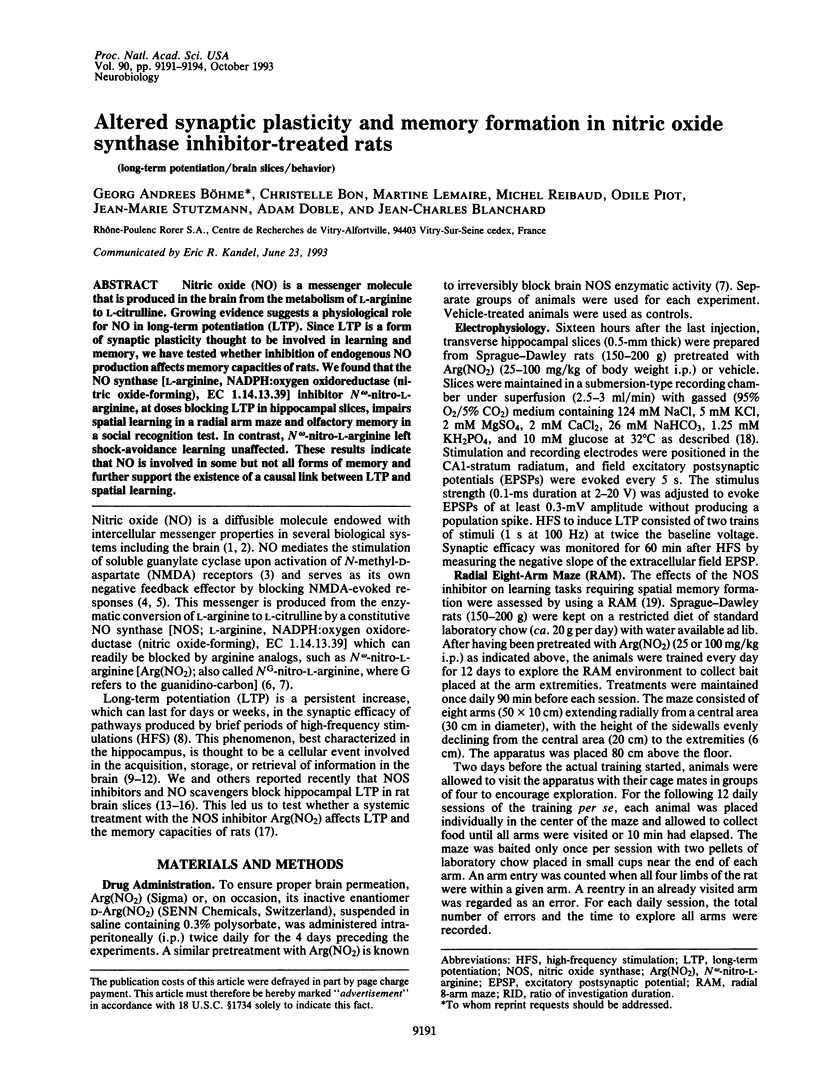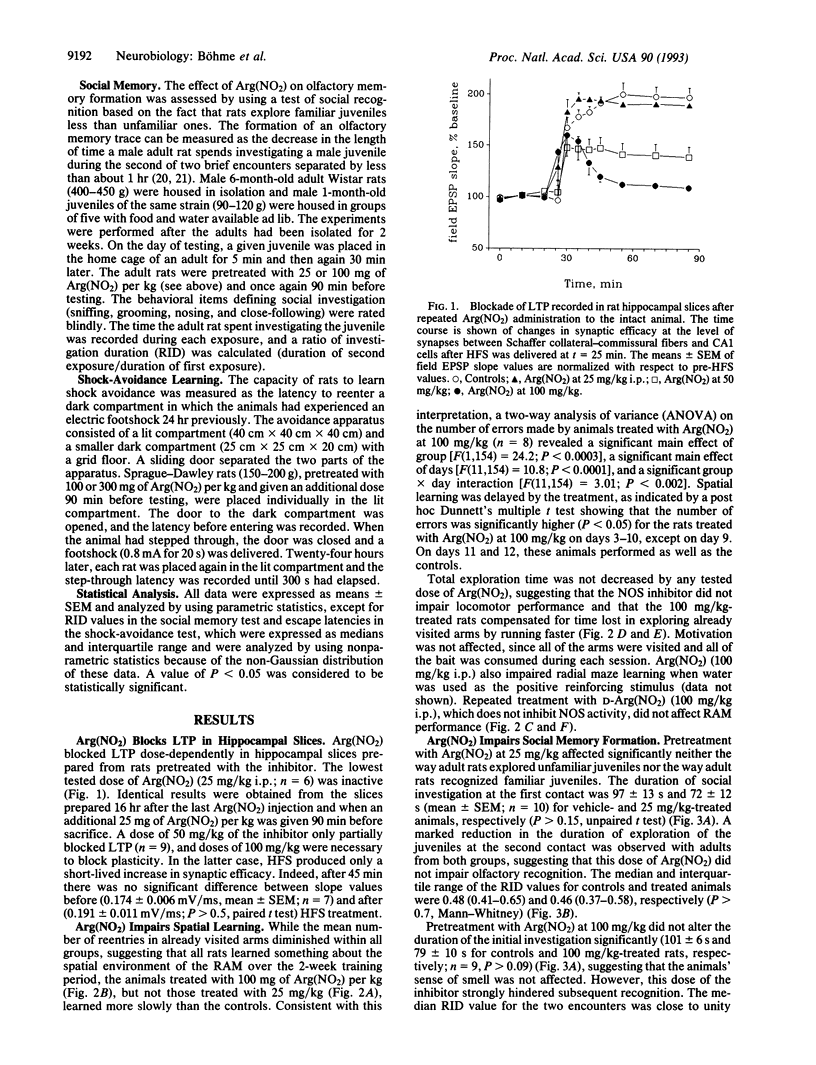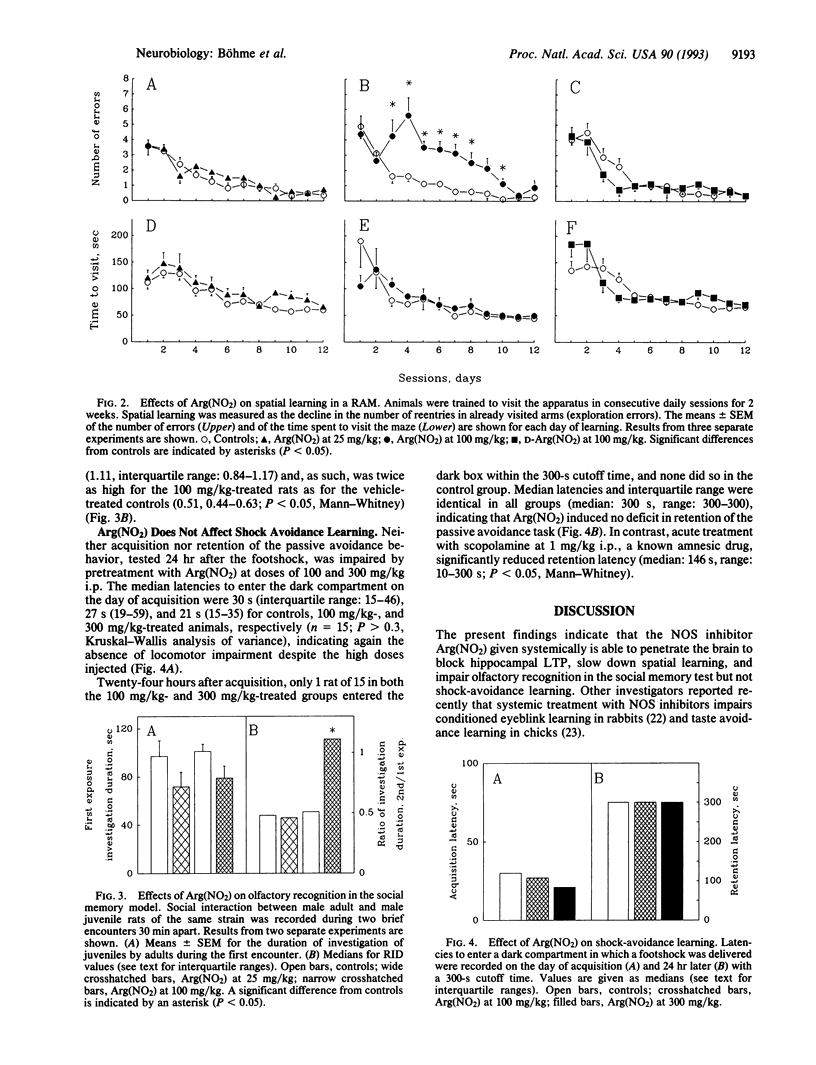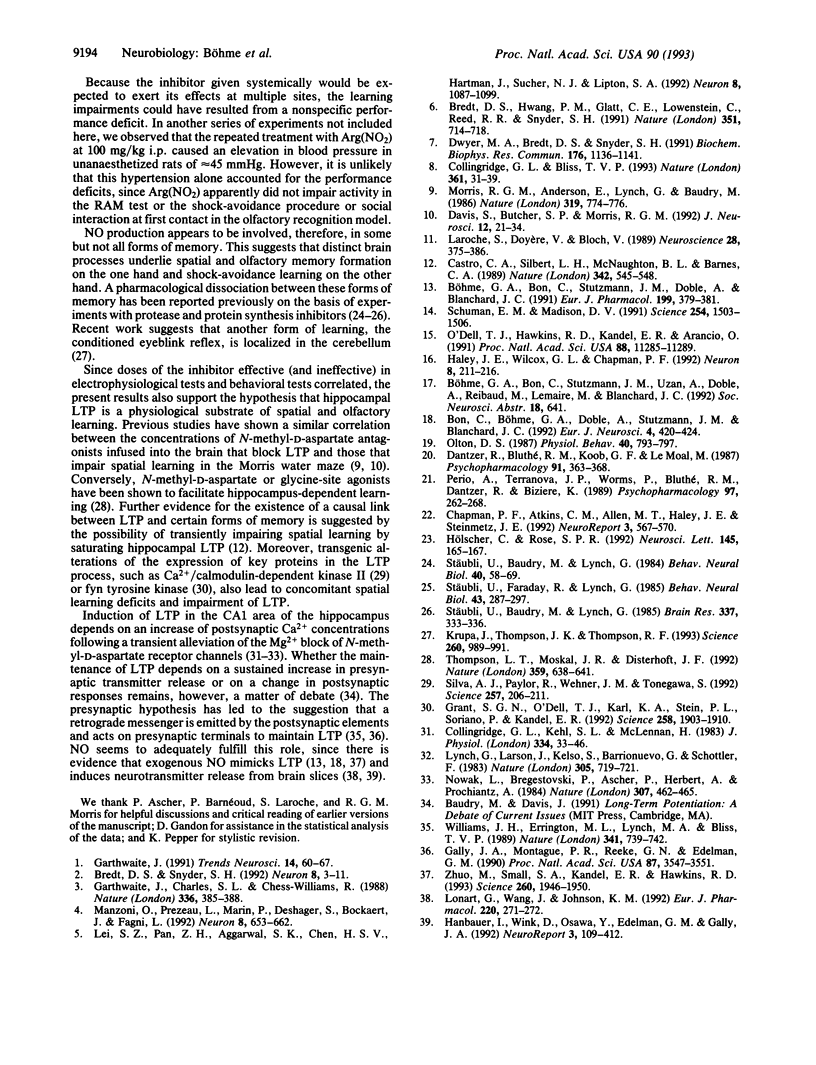Abstract
Nitric oxide (NO) is a messenger molecule that is produced in the brain from the metabolism of L-arginine to L-citrulline. Growing evidence suggests a physiological role for NO in long-term potentiation (LTP). Since LTP is a form of synaptic plasticity thought to be involved in learning and memory, we have tested whether inhibition of endogenous NO production affects memory capacities of rats. We found that the NO synthase [L-arginine, NADPH:oxygen oxidoreductase (nitric oxide-forming), EC 1.14.13.39] inhibitor N omega-nitro-L-arginine, at doses blocking LTP in hippocampal slices, impairs spatial learning in a radial arm maze and olfactory memory in a social recognition test. In contrast, N omega-nitro-L-arginine left shock-avoidance learning unaffected. These results indicate that NO is involved in some but not all forms of memory and further support the existence of a causal link between LTP and spatial learning.
Full text
PDF



Selected References
These references are in PubMed. This may not be the complete list of references from this article.
- Bliss T. V., Collingridge G. L. A synaptic model of memory: long-term potentiation in the hippocampus. Nature. 1993 Jan 7;361(6407):31–39. doi: 10.1038/361031a0. [DOI] [PubMed] [Google Scholar]
- Bon Christelle, Böhme Georg Andrees, Doble Adam, Stutzmann Jean-Marie, Blanchard Jean-Charles. A Role for Nitric Oxide in Long-term Potentiation. Eur J Neurosci. 1992;4(5):420–424. doi: 10.1111/j.1460-9568.1992.tb00891.x. [DOI] [PubMed] [Google Scholar]
- Bredt D. S., Hwang P. M., Glatt C. E., Lowenstein C., Reed R. R., Snyder S. H. Cloned and expressed nitric oxide synthase structurally resembles cytochrome P-450 reductase. Nature. 1991 Jun 27;351(6329):714–718. doi: 10.1038/351714a0. [DOI] [PubMed] [Google Scholar]
- Bredt D. S., Snyder S. H. Nitric oxide, a novel neuronal messenger. Neuron. 1992 Jan;8(1):3–11. doi: 10.1016/0896-6273(92)90104-l. [DOI] [PubMed] [Google Scholar]
- Böhme G. A., Bon C., Stutzmann J. M., Doble A., Blanchard J. C. Possible involvement of nitric oxide in long-term potentiation. Eur J Pharmacol. 1991 Jul 9;199(3):379–381. doi: 10.1016/0014-2999(91)90505-k. [DOI] [PubMed] [Google Scholar]
- Castro C. A., Silbert L. H., McNaughton B. L., Barnes C. A. Recovery of spatial learning deficits after decay of electrically induced synaptic enhancement in the hippocampus. Nature. 1989 Nov 30;342(6249):545–548. doi: 10.1038/342545a0. [DOI] [PubMed] [Google Scholar]
- Chapman P. F., Atkins C. M., Allen M. T., Haley J. E., Steinmetz J. E. Inhibition of nitric oxide synthesis impairs two different forms of learning. Neuroreport. 1992 Jul;3(7):567–570. doi: 10.1097/00001756-199207000-00005. [DOI] [PubMed] [Google Scholar]
- Collingridge G. L., Kehl S. J., McLennan H. Excitatory amino acids in synaptic transmission in the Schaffer collateral-commissural pathway of the rat hippocampus. J Physiol. 1983 Jan;334:33–46. doi: 10.1113/jphysiol.1983.sp014478. [DOI] [PMC free article] [PubMed] [Google Scholar]
- Dantzer R., Bluthe R. M., Koob G. F., Le Moal M. Modulation of social memory in male rats by neurohypophyseal peptides. Psychopharmacology (Berl) 1987;91(3):363–368. doi: 10.1007/BF00518192. [DOI] [PubMed] [Google Scholar]
- Davis S., Butcher S. P., Morris R. G. The NMDA receptor antagonist D-2-amino-5-phosphonopentanoate (D-AP5) impairs spatial learning and LTP in vivo at intracerebral concentrations comparable to those that block LTP in vitro. J Neurosci. 1992 Jan;12(1):21–34. doi: 10.1523/JNEUROSCI.12-01-00021.1992. [DOI] [PMC free article] [PubMed] [Google Scholar]
- Dwyer M. A., Bredt D. S., Snyder S. H. Nitric oxide synthase: irreversible inhibition by L-NG-nitroarginine in brain in vitro and in vivo. Biochem Biophys Res Commun. 1991 May 15;176(3):1136–1141. doi: 10.1016/0006-291x(91)90403-t. [DOI] [PubMed] [Google Scholar]
- Gally J. A., Montague P. R., Reeke G. N., Jr, Edelman G. M. The NO hypothesis: possible effects of a short-lived, rapidly diffusible signal in the development and function of the nervous system. Proc Natl Acad Sci U S A. 1990 May;87(9):3547–3551. doi: 10.1073/pnas.87.9.3547. [DOI] [PMC free article] [PubMed] [Google Scholar]
- Garthwaite J., Charles S. L., Chess-Williams R. Endothelium-derived relaxing factor release on activation of NMDA receptors suggests role as intercellular messenger in the brain. Nature. 1988 Nov 24;336(6197):385–388. doi: 10.1038/336385a0. [DOI] [PubMed] [Google Scholar]
- Garthwaite J. Glutamate, nitric oxide and cell-cell signalling in the nervous system. Trends Neurosci. 1991 Feb;14(2):60–67. doi: 10.1016/0166-2236(91)90022-m. [DOI] [PubMed] [Google Scholar]
- Grant S. G., O'Dell T. J., Karl K. A., Stein P. L., Soriano P., Kandel E. R. Impaired long-term potentiation, spatial learning, and hippocampal development in fyn mutant mice. Science. 1992 Dec 18;258(5090):1903–1910. doi: 10.1126/science.1361685. [DOI] [PubMed] [Google Scholar]
- Haley J. E., Wilcox G. L., Chapman P. F. The role of nitric oxide in hippocampal long-term potentiation. Neuron. 1992 Feb;8(2):211–216. doi: 10.1016/0896-6273(92)90288-o. [DOI] [PubMed] [Google Scholar]
- Hanbauer I., Wink D., Osawa Y., Edelman G. M., Gally J. A. Role of nitric oxide in NMDA-evoked release of [3H]-dopamine from striatal slices. Neuroreport. 1992 May;3(5):409–412. doi: 10.1097/00001756-199205000-00008. [DOI] [PubMed] [Google Scholar]
- Hölscher C., Rose S. P. An inhibitor of nitric oxide synthesis prevents memory formation in the chick. Neurosci Lett. 1992 Oct 12;145(2):165–167. doi: 10.1016/0304-3940(92)90012-v. [DOI] [PubMed] [Google Scholar]
- Krupa D. J., Thompson J. K., Thompson R. F. Localization of a memory trace in the mammalian brain. Science. 1993 May 14;260(5110):989–991. doi: 10.1126/science.8493536. [DOI] [PubMed] [Google Scholar]
- Laroche S., Doyere V., Bloch V. Linear relation between the magnitude of long-term potentiation in the dentate gyrus and associative learning in the rat. A demonstration using commissural inhibition and local infusion of an N-methyl-D-aspartate receptor antagonist. Neuroscience. 1989;28(2):375–386. doi: 10.1016/0306-4522(89)90184-x. [DOI] [PubMed] [Google Scholar]
- Lei S. Z., Pan Z. H., Aggarwal S. K., Chen H. S., Hartman J., Sucher N. J., Lipton S. A. Effect of nitric oxide production on the redox modulatory site of the NMDA receptor-channel complex. Neuron. 1992 Jun;8(6):1087–1099. doi: 10.1016/0896-6273(92)90130-6. [DOI] [PubMed] [Google Scholar]
- Lonart G., Wang J., Johnson K. M. Nitric oxide induces neurotransmitter release from hippocampal slices. Eur J Pharmacol. 1992 Sep 22;220(2-3):271–272. doi: 10.1016/0014-2999(92)90759-w. [DOI] [PubMed] [Google Scholar]
- Lynch G., Larson J., Kelso S., Barrionuevo G., Schottler F. Intracellular injections of EGTA block induction of hippocampal long-term potentiation. Nature. 1983 Oct 20;305(5936):719–721. doi: 10.1038/305719a0. [DOI] [PubMed] [Google Scholar]
- Manzoni O., Prezeau L., Marin P., Desagher S., Deshager S., Bockaert J., Fagni L. Nitric oxide-induced blockade of NMDA receptors. Neuron. 1992 Apr;8(4):653–662. doi: 10.1016/0896-6273(92)90087-t. [DOI] [PubMed] [Google Scholar]
- Morris R. G., Anderson E., Lynch G. S., Baudry M. Selective impairment of learning and blockade of long-term potentiation by an N-methyl-D-aspartate receptor antagonist, AP5. 1986 Feb 27-Mar 5Nature. 319(6056):774–776. doi: 10.1038/319774a0. [DOI] [PubMed] [Google Scholar]
- Nowak L., Bregestovski P., Ascher P., Herbet A., Prochiantz A. Magnesium gates glutamate-activated channels in mouse central neurones. Nature. 1984 Feb 2;307(5950):462–465. doi: 10.1038/307462a0. [DOI] [PubMed] [Google Scholar]
- O'Dell T. J., Hawkins R. D., Kandel E. R., Arancio O. Tests of the roles of two diffusible substances in long-term potentiation: evidence for nitric oxide as a possible early retrograde messenger. Proc Natl Acad Sci U S A. 1991 Dec 15;88(24):11285–11289. doi: 10.1073/pnas.88.24.11285. [DOI] [PMC free article] [PubMed] [Google Scholar]
- Olton D. S. The radial arm maze as a tool in behavioral pharmacology. Physiol Behav. 1987;40(6):793–797. doi: 10.1016/0031-9384(87)90286-1. [DOI] [PubMed] [Google Scholar]
- Perio A., Terranova J. P., Worms P., Bluthe R. M., Dantzer R., Biziere K. Specific modulation of social memory in rats by cholinomimetic and nootropic drugs, by benzodiazepine inverse agonists, but not by psychostimulants. Psychopharmacology (Berl) 1989;97(2):262–268. doi: 10.1007/BF00442261. [DOI] [PubMed] [Google Scholar]
- Schuman E. M., Madison D. V. A requirement for the intercellular messenger nitric oxide in long-term potentiation. Science. 1991 Dec 6;254(5037):1503–1506. doi: 10.1126/science.1720572. [DOI] [PubMed] [Google Scholar]
- Silva A. J., Paylor R., Wehner J. M., Tonegawa S. Impaired spatial learning in alpha-calcium-calmodulin kinase II mutant mice. Science. 1992 Jul 10;257(5067):206–211. doi: 10.1126/science.1321493. [DOI] [PubMed] [Google Scholar]
- Stäubli U., Baudry M., Lynch G. Leupeptin, a thiol proteinase inhibitor, causes a selective impairment of spatial maze performance in rats. Behav Neural Biol. 1984 Jan;40(1):58–69. doi: 10.1016/s0163-1047(84)90170-5. [DOI] [PubMed] [Google Scholar]
- Stäubli U., Baudry M., Lynch G. Olfactory discrimination learning is blocked by leupeptin, a thiol protease inhibitor. Brain Res. 1985 Jul 1;337(2):333–336. doi: 10.1016/0006-8993(85)90070-8. [DOI] [PubMed] [Google Scholar]
- Stäubli U., Faraday R., Lynch G. Pharmacological dissociation of memory: anisomycin, a protein synthesis inhibitor, and leupeptin, a protease inhibitor, block different learning tasks. Behav Neural Biol. 1985 May;43(3):287–297. doi: 10.1016/s0163-1047(85)91632-2. [DOI] [PubMed] [Google Scholar]
- Thompson L. T., Moskal J. R., Disterhoft J. F. Hippocampus-dependent learning facilitated by a monoclonal antibody or D-cycloserine. Nature. 1992 Oct 15;359(6396):638–641. doi: 10.1038/359638a0. [DOI] [PubMed] [Google Scholar]
- Williams J. H., Errington M. L., Lynch M. A., Bliss T. V. Arachidonic acid induces a long-term activity-dependent enhancement of synaptic transmission in the hippocampus. Nature. 1989 Oct 26;341(6244):739–742. doi: 10.1038/341739a0. [DOI] [PubMed] [Google Scholar]
- Zhuo M., Small S. A., Kandel E. R., Hawkins R. D. Nitric oxide and carbon monoxide produce activity-dependent long-term synaptic enhancement in hippocampus. Science. 1993 Jun 25;260(5116):1946–1950. doi: 10.1126/science.8100368. [DOI] [PubMed] [Google Scholar]


